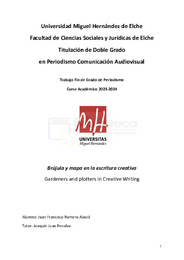Please use this identifier to cite or link to this item:
https://hdl.handle.net/11000/33498Brújula y mapa en la escritura creativa
| Title: Brújula y mapa en la escritura creativa |
| Authors: Romero Alacid, Juan Francisco |
| Tutor: JUAN-PENALVA, Joaquín |
| Editor: Universidad Miguel Hernández de Elche |
| Department: Departamentos de la UMH::Ciencias Sociales y Humanas |
| Issue Date: 2024-06 |
| URI: https://hdl.handle.net/11000/33498 |
| Abstract: El arte de contar historias ha evolucionado de la mano del ser humano que las cuenta, donde cada técnica narrativa genera un mundo radicalmente distinto. El foco de este trabajo recae en dos metodologías principales: la de brújula y la de mapa. La metodología de brújula se caracteriza por una escritura intuitiva y libre, donde el autor descubre la historia a medida que avanza, mientras que la metodología de mapa implica una planificación detallada y estructurada antes de comenzar la redacción. Para ilustrar las diferencias y el impacto de cada enfoque, se examinan dos relatos: The Gunslinguer (King, 1982), de un autor conocido por su uso del formato de brújula, y Alomante Jak (Sanderson, 2017), de un autor que emplea el formato de mapa. El relato de King muestra una narrativa que fluye de manera orgánica, con giros inesperados y una evolución natural de los personajes y la trama, mientras que el relato de Sanderson presenta una construcción meticulosa y coherente, con una estructura clara y elementos cuidadosamente planificados que se entrelazan a lo largo de la historia. Los resultados del análisis confirman que la metodología utilizada tiene un impacto significativo en la forma y el desarrollo de la narrativa. La metodología de brújula aporta frescura y espontaneidad, resultando en sorpresas y una conexión más visceral con los personajes, mientras que la metodología de mapa garantiza coherencia y solidez en la trama, ofreciendo una experiencia de lectura más estructurada. Ambas metodologías tienen ventajas distintivas y su elección depende del objetivo narrativo del autor, evidenciando que la metodología empleada influye en la forma general de la historia contada. The art of storytelling has evolved alongside the humans who tell these stories, with each narrative technique generating a radically different world. This work focuses on two main methodologies: the "gardener" method and the "plotter" method. The gardener method is characterized by intuitive and free writing, where the author discovers the story as it progresses, while the plotter method involves detailed and structured planning before beginning the writing process. To illustrate the differences and the impact of each approach, two stories are examined: The Gunslinger (King, 1982), by an author known for using the pantser format, and Mistborn: Secret History (Sanderson, 2017), by an author who employs the plotter format. King's story shows a narrative that flows organically, with unexpected twists and a natural evolution of characters and plot, while Sanderson's story presents a meticulous and coherent construction, with a clear structure and carefully planned elements that intertwine throughout the narrative. The results of the analysis confirm that the methodology used has a significant impact on the form and development of the narrative. The gardener method brings freshness and spontaneity, resulting in surprises and a more visceral connection with the characters, while the plotter method guarantees coherence and solidity in the plot, offering a more structured reading experience. Both methodologies have distinctive advantages, and their choice depends on the author's narrative goal, demonstrating that the employed methodology influences the overall shape of the story told. |
| Keywords/Subjects: Narrativa Metodología Escritura creativa Brújula Mapa Narrative Methodology Creative writing Gardener Plotter |
| Knowledge area: CDU: Generalidades.: Periódicos. Prensa. Periodismo. Ciencias de la información |
| Type of document: info:eu-repo/semantics/bachelorThesis |
| Access rights: info:eu-repo/semantics/openAccess Attribution-NonCommercial-NoDerivatives 4.0 Internacional |
| Appears in Collections: TFG - Doble Grado en Comunicación Audiovisual y Periodismo |
.png)

